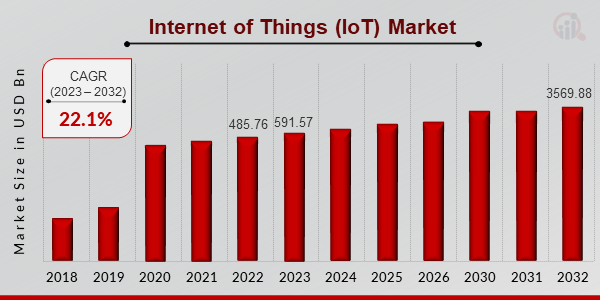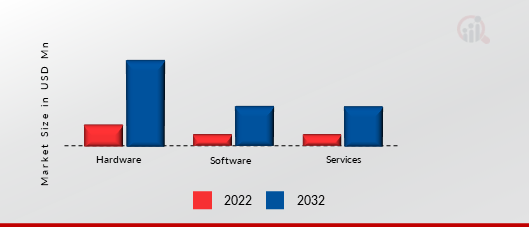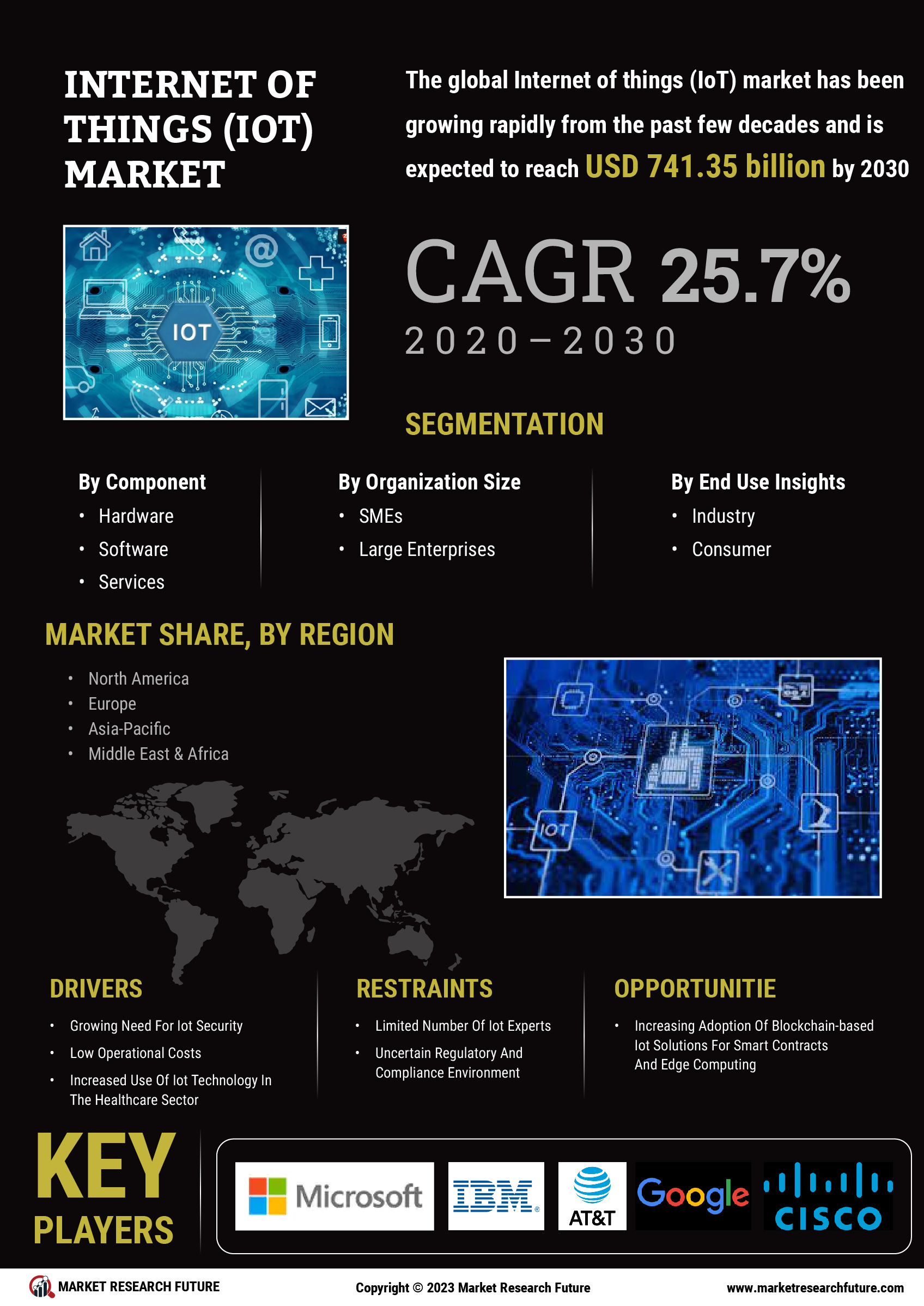Internet of Things (IoT) Market Overview
Internet of Things (IoT) Market Size was valued at USD 485,768.3 Million in 2022. The Internet of Things (IoT) market industry is projected to grow from USD 591578.6 Million in 2023 to USD 3569884.5 Million by 2032, exhibiting a compound annual growth rate (CAGR) of 22.1% during the forecast period (2023 - 2032). The Internet of Things (IoT) Market is expected to grow significantly over the forecast period due to several factors. The growth of the Internet of Things (IoT) Market is expected to be driven by key factors such as increasing demand for better integration in sectors reliant on sensor-based measurements, synergy between IoT and data analytics and addressing industry-specific needs. However, factors such as lack of advancements in communication technology and security concerns due to the collection and transmission of sensitive information are expected to restrict market growth. On the other hand, continual development, and growth of the global IoT market and tailored IoT solutions for various sectors, such as agriculture, healthcare, manufacturing, and logistics pose lucrative opportunities for the Global market.
As per Analyst at MRFR, “Growing trend of IoT adoption, the devices and objects are increasingly equipped with sensors and software that can collect, analyze, and use data in various industries, leading to process improvements and greater efficiency. As IoT evolves, devices are becoming smarter and able to collect, analyze, and provide valuable insights from the data they collect. The Internet of Things (IoT) market is growing rapidly owing to the increased.
Figure 1: Internet of Things (IoT) Market, 2022 - 2032 (USD Billion)

Source: Secondary Research, Primary Research, MRFR Database, and Analyst Review
Internet of Things (IoT) Market Opportunity
-
Synergy Between IOT and Data Analytics
The convergence of Internet of Things (IoT) and Data Analytics holds immense potential for driving the IoT market. By leveraging the progress made in the field of data analytics organizations are being able to extract valuable insights from the vast amount of data generated by IoT devices. This synergy enhances decision-making, improves operational efficiency, and enables innovative solutions across various industries. The role of data analytics in IoT is reshaping the market and driving its growth, some of the major benefits of integration of data analytics with IoT are Raw data generated by IoT devices is often unstructured and lacks meaning. Data analytics steps in to clean, aggregate, and organize this data, converting it into useful information that organizations can use to make informed decisions. By doing so, data analytics helps organizations extract actionable insights and identify patterns and trends that would otherwise remain hidden.
IoT applications frequently require timely responses, and data analytics makes this possible. With the ability to monitor IoT data in real-time, organizations can detect anomalies or patterns that demand immediate attention. This capacity is essential in scenarios such as predictive maintenance in industrial IoT or healthcare monitoring, where timely interventions can have a significant impact on outcomes. Data analytics in IoT extends beyond descriptive analysis, offering predictive and prescriptive analytics capabilities. Predictive analytics leverages historical data to forecast future events or trends, allowing organizations to prepare for upcoming challenges. Prescriptive analytics takes this a step further, suggesting specific actions to optimize outcomes. For instance, in smart agriculture, predictive analytics can anticipate crop diseases, while prescriptive analytics can advise farmers on optimal irrigation levels to prevent disease and improve yields.
Internet of Things (IoT) Market Component Segment Insights
Internet of Things (IoT) Component Insights
Based on component, the Internet of Things (IoT) Market segmentation includes hardware, software, and Services. The Hardware segment held the majority share in 2022, contributing around ~39.6% to the market revenue. IoT hardware refers to the actual equipment and components that comprise an IoT system. These devices may be sensors, actuators, camera modules, gateways, microcontrollers, or routing devices. Consider components in charge of security, internet and device connectivity (such as IoT protocols), IoT ecosystem activation, and data gathering. An IoT solution's hardware often comprises a network infrastructure for connecting devices. Non-IP Enabled Devices devices do not connect to the internet directly, but their communications are routed through other hardware, such as a field gateway. To communicate with other hardware, devices can employ industry-specific protocols such as CoAP5 and OPC, as well as short-range communication technologies like Bluetooth and ZigBee. For example, while setting up an internet-connected lock, customers may need to link the lock to their phone via Bluetooth in order to establish a connection with a cloud service. While this is a transitory condition, consider a scenario in which the device can only connect to a local device over Bluetooth and the secondary device handles all communication with the cloud service. An IP-enabled device is one that can connect to a network--for many IoT devices, this is the internet--and has a distinct identity on that network. In terms of IoT, an IP-enabled device is one that can connect directly to a network (such as the internet) and send or receive data. Common examples are home automation devices like doorbells and thermostats, which interact with a central server via an internet connection. Industrial-grade IoT devices can also be IP-enabled; however, this feature requires specific hardware.
Figure 2: Internet of Things (IoT) Market, by Component, 2022 & 2032 (USD Million)

Source: Secondary Research, Primary Research, MRFR Database, and Analyst Review
Internet of Things (IoT) Market Connectivity Platform Segment Insights
Internet of Things (IoT) Connectivity Platform Insights
Based on Connectivity Platform, the Internet of Things (IoT) Market segmentation includes Cellular, Wi-Fi, Ethernet, Bluetooth, Zigbee and Others. The Wi-fi segment held the majority share in 2022 contributing around ~32.2% to the market revenue. Wi-Fi accounts for 32.1% of all IoT connections. More than half of all Wi-Fi-enabled devices released in 2022 used the most recent Wi-Fi 6 and Wi-Fi 6E technologies, which promise quicker and more stable wireless access. The introduction of these technologies has made communication between IoT devices more efficient, resulting in better user experiences and overall performance. Wi-Fi technology is driving IoT connection in industries including smart homes, buildings, and healthcare. Specialists believe Wi-Fi to be the most feasible connectivity choice for their IoT projects. Experts commonly employ this technology in smart home devices such as bulbs, LED strips, relays, and so on. They also use it in IoT device development, notably when writing firmware for chips, which have built-in Wi-Fi modules.
Internet of Things (IoT) Market Organization Size Segment Insights
Internet of Things (IoT) Organization Size Insights
Based on the Organization Size, the Internet of Things (IoT) Market segmentation includes Small & Medium Enterprise and Large Enterprise. By Organization Size, Large Enterprise segment hold the majority market share in 2022 contributing 65.4% of the market share. Large businesses have already started to reap the benefits of IoT. By incorporating IoT into their operations, these businesses may boost efficiency, save operating costs, and improve decision-making processes. IoT devices generate real-time data, allowing businesses to respond quickly to changes and make data-driven choices. Additionally, predictive maintenance provided by IoT may drastically minimize downtime, increasing productivity. This transformational technology ushers in a new era of operational efficiency in the commercial sector.
The use of IoT technology in inventory management is a game changer, dramatically lowering human labour and mistakes while increasing processing speeds. This in turn improves overall warehouse efficiency. Currently, Small and Medium-sized Enterprises (SMEs) are using IoT sensors in their warehouse. These sensors track the movement and usage of materials and other assets in their facilities. The use of IoT enables enterprises to decrease the amount of costly and time-consuming mistakes. Employees may use IoT to efficiently check inventory levels and know where equipment is located. This technological connection simplifies warehouse operations, paving the way for automated and error-free inventory management in the future.
Internet of Things (IoT) Market end use Industry Segment Insights
Internet of Things (IoT) end use Industry Insights
Based on the end use Industry, the Internet of Things (IoT) Market segmentation includes Manufacturing, Transportation, Logistics, Construction, Healthcare, Automotive, Retail, IT & Telecom, Utility, and Others. By end use Industry, Manufacturing segment hold the majority market share in 2022 contributing 19.6% of the market share. The Internet of Things (IoT) is no longer a luxury in the fast-changing manufacturing industry; it is a requirement. Industry 4.0 introduces technical breakthroughs that help organizations become more adaptive, inventive, and resilient. These capabilities, which range from artificial intelligence to wearables and 3D printing, are creating disruptive IoT use cases in manufacturing while also offering significant ROI. The IoT in the industrial business, also known as IIoT (Industrial Internet of Things), has far-reaching ramifications for operations. This describes how organizations make items, sell to clients, and provide assistance. With the availability of IoT infrastructure and robots in the home, more enterprises will begin to leverage IoT in manufacturing and industry. IoT in manufacturing is causing unprecedented upheaval and can help make factories safer for front-line workers while enhancing production and efficiency. With this, we can definitely declare that IIoT is a key driving factor behind Industry 4.0.
Returning to the deployment of IoT, expectations in the industrial business are significantly greater. There is a strong and unwavering desire for consistent growth and customisation, as well as supply complications. Aside from these hard requirements, businesses, manufacturers, and product makers are seeking for novel ways to compete and dominate the market.
Internet of Things (IoT) Regional Insights
By Region, the study provides market insights into North America, Europe, Asia-Pacific, Middle East & Africa, and South America. In terms of revenue, Asia-Pacific held the largest share of 38.7% in the Internet of Things (IoT) market in 2022 and is expected to maintain its dominance during the forecast period. IoT adoption is particularly strong in asset-intensive industries such as manufacturing, transportation, and utilities. Whether fixed or mobile, these assets are now part of a linked ecosystem in which they may interact and share critical information with one another. Shipment vehicles, such as trucks and ship boats, are moveable assets that are becoming an important element of the IoT network and have a long-term impact on the logistics business. Even before the phrase "Internet of Things" was invented, the logistics and warehousing sectors were among the first to use linked technologies. This early adoption has allowed these sectors to thrive while also empowering other industrial segments to improve their supply chain management and other end-to-end operations. The Internet of Things in the logistics vertical has transformed the business with better telemetry capabilities and monitoring systems. Clearly, IoT for the logistics industry is a gift. Its deployment has enabled a logistics company to change its operations and get better outcomes. As previously stated, the logistics sector used linked infrastructures even before the term "IoT" was coined. This linked ecosystem was created in response to the logistics industry's demand to track delivery vehicles (particularly trucks) from remote areas and assure timely delivery of shipments to their destinations.
Figure 3: INTERNET OF THINGS (IOT) MARKET SIZE BY REGION 2022 & 2032

Source: Secondary Research, Primary Research, MRFR Database, and Analyst Review
Further, the major countries studied in the market report are the U.S., Canada, Germany, France, the UK, Italy, Spain, China, Japan, India, Australia, South Korea, and Brazil.
Smart cities in the construction, smart cities incorporate technology into several parts of city administration such as water management, traffic flow, waste management, public safety, and education to not only raise the quality of life for people but also maximize resources. Keep in mind that smart devices are an extension of the Internet of Things idea to a wide range of community projects. The construction sector benefits from a wide range of IoT (Internet of Things) technologies, which improve efficiency, safety, and resource management.
IoT sensors can monitor building sites in real time, providing important data on a variety of safety factors. These include supervising worker movements to verify compliance with safety requirements, monitoring environmental variables including temperature and humidity, and identifying possible hazards such as gas leaks or fires. Additionally, IoT-enabled cameras and sensors help with security by detecting unwanted entry. IoT technology allows for real-time tracking and monitoring of construction equipment and assets. This includes tracking the location, status, and use of machines, tools, and materials. It helps minimize theft, optimize equipment deployment, and ensure timely maintenance. IoT sensors are used to efficiently manage resource use. This involves monitoring energy and water consumption to reduce waste and improve sustainability. By evaluating resource data, building organizations may uncover cost-cutting opportunities and apply eco-friendly methods.
Internet of Things (IoT) Key Market Players & Competitive Insights
With a strong presence across different verticals and geographies, the Internet of Things (IoT) market is highly competitive and dominated by established, pure-play vendors. Over 30 vendors cater to this market, and they continually innovate their solutions to meet the evolving needs of businesses by adopting new technologies to make business more effective. These vendors have a robust geographic footprint and partner ecosystem to cater to diverse customer segments. The Internet of Things (IoT) market is highly competitive, with many vendors offering similar products and services.
The major players in the market include NETOBJEX INC, SAMSARA, Amazon Web Services (AWS), AT&T Inc., Cisco Systems, Inc., Google LLC, Oracle Corporation, Dell, Microsoft Corporation, Hitachi Ltd, Huawei Technologies Co. Ltd., IBM Corporation, and Others.
Amazon Web Services strategies to evaluates trade-offs between the amount of change, the cost of retraining, and the potential value of having a newer model in production. Set up automated retraining based on the strategy defined. Data used for ML could be collected from multiple sources and needs to be available to various teams across your organization. Because production data is required for data science development activities and training models, ensuring teams have end-to-end access to high-quality datasets requires a data governance strategy that ensures the integrity, security, and availability of datasets. Identifying the correct service or tools to use for creating an automated pipeline for model deployment relies on identifying the deployment strategy, model characteristics, and model training strategy. Identify and implement a deployment strategy that satisfies the requirements of your use case and business problem. If required, include human quality gates in your pipeline to have humans evaluate if a model is ready to deploy to a target environment.
The Internet of Things (IoT) Market is a consolidated market due to increasing competition, acquisitions, mergers, and other strategic market developments and decisions to improve operational effectiveness.
Key Companies in the Internet of Things (IoT) market include
Internet of Things (IoT) Industry Developments
- In November 2023, Siemens and AWS simplify IT/OT convergence with an integrated edge-to-cloud experience.
- In November 2023, Amazon Web Services Inc. (AWS) will be available on the Siemens Industrial Edge Marketplace. Users can deploy it on Siemens Industrial Edge for centralized app and device management and combine it with other apps and edge devices, from both Siemens and other vendors, to configure specific IoT solutions.
Internet of Things (IoT) Market Segmentation
Internet of Things (IoT) Component Outlook
- Hardware
- Network Devices
- Sensors
- Camera
- Others
- Software
- Industrial Application/ Solution
- Platform
- Cloud
- Security
- Connectivity Management
- Device Management
- Services
- Professional Services
- Managed Services
Internet of Things (IoT) Connectivity Platform Outlook
- Cellular
- Wi-Fi
- Ethernet
- Bluetooth
- Zigbee
- Others
Internet of Things (IoT) Sales Channel Outlook
- Small & Medium Enterprise
- Large Enterprise
Internet of Things (IoT) end use Industry Outlook
- Manufacturing
- Transportation
- Logistics
- Construction
- Healthcare
- Automotive
- Retail
- IT & Telecom
- Utility
- Others
Internet of Things (IoT) Regional Outlook
- North America
- Europe
- Germany
- France
- UK
- Spain
- Rest of Europe
- Asia-Pacific
- China
- Japan
- India
- South Korea
- Rest of Asia-Pacific
- Middle East & Africa
- UAE
- Saudi Arabia
- South Africa
- Rest of Middle East & Africa
- South America
- Chile
- Brazil
- Rest of South America
|
Report Attribute/Metric
|
Details
|
|
Market Size 2022
|
USD 485,768.3 Million
|
|
Market Size 2023
|
USD 591,578.6 Million
|
|
Market Size 2032
|
USD 3,569,884.5 Million
|
|
Compound Annual Growth Rate (CAGR)
|
22.1% (2023-2032)
|
|
Base Year
|
2022
|
|
Market Forecast Period
|
2023-2032
|
|
Historical Data
|
2019- 2022
|
|
Market Forecast Units
|
Value (USD Million)
|
|
Report Coverage
|
Revenue Forecast, Market Competitive Landscape, Growth Factors, and Trends
|
|
Segments Covered
|
Component, Deployment Mode, Organization Size, Vertical, and Region
|
|
Geographies Covered
|
Europe, North America, Asia-Pacific, Middle East & Africa, and South America
|
|
Countries Covered
|
The U.S, Germany, Canada, U.K., Italy, France, Spain, Japan, China, Australia, India, South Korea, Brazil, and others.
|
|
Key Companies Profiled
|
NETOBJEX INC, SAMSARA, Amazon Web Services (AWS), AT&T Inc., Cisco Systems, Inc., Google LLC, Oracle Corporation, Dell, Microsoft Corporation, Hitachi Ltd, Huawei Technologies Co. Ltd., IBM Corporation and Others.
|
|
Key Market Opportunities
|
·Continual development and growth of the global IOT market.·Tailored IOT solutions for various sectors, such as agriculture, healthcare, manufacturing, and logistics·Increasing adoption of IOT across all industry verticals.·Market white space assessment and opportunity analysis.·Cloud managed services market opportunity assessment |
|
Key Market Dynamics
|
·Increasing Demand for Better Integration In Sectors Reliant On Sensor-Based Measurements.
·Synergy Between IOT and Data Analytics.
|
Internet of Things Market Highlights:
Frequently Asked Questions (FAQ) :
The Internet of Things (IoT) Market size is expected to be valued at USD 485,768.3 Million in 2022.
The global market is projected to grow at a CAGR of 22.1% during the forecast period, 2023-2032.
Asia Pacific had the largest share of the global market.
The key players in the market are NETOBJEX INC, SAMSARA, Amazon Web Services (AWS), AT&T Inc., Cisco Systems, Inc., Google LLC, Oracle Corporation, Dell, Microsoft Corporation, Hitachi Ltd, Huawei Technologies Co. Ltd., IBM Corporation, and Others.
The Hardware category dominated the market in 2022.



























